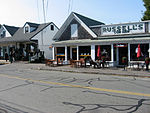East Sandwich station
Former Old Colony Railroad stationsFormer railway stations in MassachusettsMassachusetts railway station stubsPages with no open date in Infobox stationRailway stations in Barnstable County, Massachusetts ... and 1 more
Sandwich, Massachusetts

East Sandwich station is a former train station located in East Sandwich, Massachusetts. The station was built by the Cape Cod Branch Railroad when the line was extended beyond Sandwich. A new station building was constructed in 1893. The station building still exists as a private residence at 404 Old Kings Highway (Massachusetts 6A), although it is much changed from its original appearance. It was moved back from the tracks, rotated almost 90 degrees, and had several additions made.
Excerpt from the Wikipedia article East Sandwich station (License: CC BY-SA 3.0, Authors, Images).East Sandwich station
Route 6A,
Geographical coordinates (GPS) Address Nearby Places Show on map
Geographical coordinates (GPS)
| Latitude | Longitude |
|---|---|
| N 41.740286111111 ° | E -70.448144444444 ° |
Address
Route 6A 392
02537
Massachusetts, United States
Open on Google Maps






